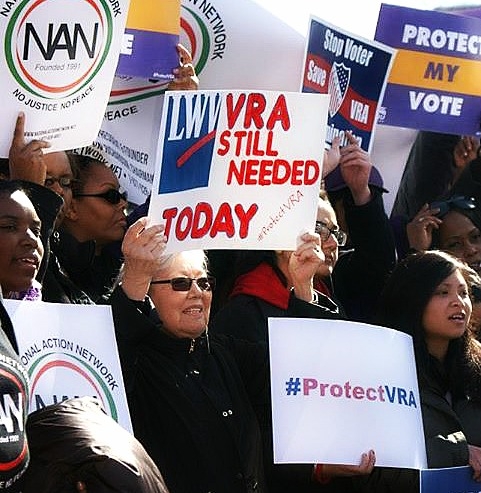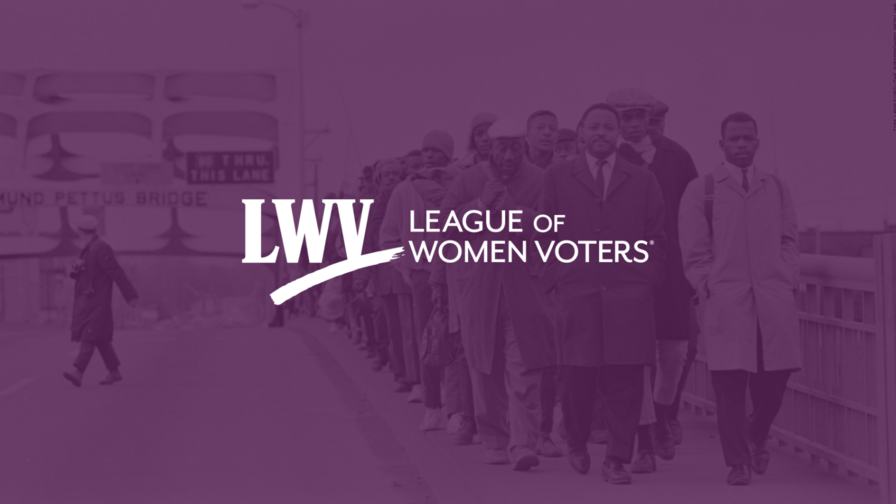Selma and Current Threats to the Voting Rights Act
This blog was updated June 20, 2023.
Today marks the 58th anniversary of Bloody Sunday, when state and local police attacked hundreds of civil rights marchers during a march from Selma, Alabama to the state capital in Montgomery to protest police brutality and racial discrimination in voting.
As activists gathered in Selma on Sunday to reenact the steps of marchers like John Lewis and Martin Luther King, Jr., we are reminded that the fight for voting rights is as alive today as it was on that fateful day in 1965. Indeed, the landmark law passed after Bloody Sunday — the Voting Rights Act of 1965 — is in critical condition.
The March 7, 1965 Selma-to-Montgomery march was organized to protest the murder of Jimmie Lee Jackson by police during a peaceful protest for voting rights in Marion, Alabama. As marchers crossed the Edmund Pettus Bridge, they met a wall of state and county police, many on horseback. The police charged and chased the marchers, hitting them with police weapons and injuring dozens of men, women, and children as they ran in terror. The brutality of Bloody Sunday was broadcast around the country, bringing national attention to racial violence and discrimination in the fight for equal voting rights in the American South.
Bloody Sunday catalyzed the passage of the most successful and impactful civil rights law ever passed: the Voting Rights Act of 1965 (VRA). The VRA was desperately needed because states, particularly in the Deep South, were evading their obligations under the Fourteenth and Fifteenth Amendments to provide equal access to the ballot regardless of race. The VRA immediately struck down racially discriminatory barriers to voting, like literacy tests. It also prevented areas with histories of racial discrimination in voting from making future changes to voting laws or practices unless they received federal approval — this provision was known as federal preclearance, or Section 5.

The VRA also put in place an affirmative process for voters to sue any jurisdiction for racial discrimination in voting. Section 2 of the VRA, among other critical provisions, prohibits voting practices or procedures that discriminate on the basis of race, color, or membership in a language minority group.
Sections 2 and 5 of the VRA were critical because even after the reality of racial terror in the American South was exposed, many Southern states continued to take affirmative steps to prevent any gains in political power by Black Americans. Jurisdictions continued to thwart their obligations under the Fourteenth and Fifteenth Amendments — and now the Voting Rights Act — but their actions were now facially neutral on race. Sections 2 and 5 of the VRA provided the tools to prevent classic instruments of racial discrimination in political participation, including:
1) moving from electing candidates by district to an at-large voting scheme;
2) annexing large white populations into districts where people of color are the majority;
3) racially discriminatory redistricting plans where communities of color are either packed together or cracked apart to reduce their power;
and many others.
The Elimination of the VRA’s Section 5
The VRA was reauthorized with broad bipartisan support in 1970, 1975, 1982, 1992, and 2006. Each time, protections for voters were strengthened. From 1965 to 2013, Section 5 prevented hundreds of racially discriminatory voting practices from going into effect in areas with histories of disenfranchising Black voters.
Yet in 2013, the US Supreme Court rendered Section 5 inoperative by striking down its formula for deciding which jurisdictions must follow its preclearance terms. This case is known as Shelby County v. Holder. A bill to rewrite the coverage formula has failed to pass out of Congress since then.
The loss of Section 5 cannot be overstated. Section 5 prohibited states from enacting racial discrimination measures in voting without federal oversight and blocked racial discrimination before certain laws could be implemented. Immediately after it was dismantled, previously covered states like Texas, Alabama, and North Carolina passed legislation known to disenfranchise Black voters and other voters of color. Section 2 litigation was one of the only tools left to pick up the pieces.
Section 2 and Merrill v. Milligan (now Allen v. Milligan)
Section 2 has protected our democracy from politicians and governments that seek to dilute the political power of communities of color to overinflate and maintain the political power of white communities. In recent years, an already weakened Section 2 has been under attack by jurisdictions seeking unchecked power to disenfranchise and disempower Black communities.
A recent case before the US Supreme Court — Merrill v. Milligan — threatened to provide the final blow to Section 2 of the Voting Rights Act, preventing its use to challenge racially discriminatory voting practices. The case, brought by Alabama voter Evan Milligan, Alabama voting rights organizations, and other individual voters, successfully challenged Alabama’s congressional map passed after the 2020 census. Alabama’s map contained only one majority-Black congressional district out of six despite Alabama having 27% Black population. A three-judge federal court held that Alabama’s map violated Section 2 of the Voting Rights Act by diluting the political power of Black voters and ordered the state to redraw the map.
Instead of working to address the Section 2 violation and draw a new map, the state of Alabama appealed to the US Supreme Court, arguing that the lower court erred when it considered the race of voters when drawing the maps. The Milligan plaintiffs argued, and LWVUS agreed, that race cannot be removed from the Section 2 analysis when Section 2 was passed to end racial discrimination against voters of color.
A decision in Merrill v. Milligan (now known as Allen v. Milligan) was made in June 2023, with SCOTUS upholding a lower court ruling that Alabama must create a second majority Black congressional district in compliance with Section 2 of the Voting Rights Act.
The Fight for Voting Rights Today
Today, as we reflect on what happened 58 years ago, we remember that the fight for voting rights is ongoing and still close to home in many communities around the country.
Alabama is home to the state troopers who beat peaceful protestors. But it is also home to the marchers who took to the Edmund Pettus Bridge three times to march for civil rights, voting rights, and freedom in the face of violence and hatred and made it to Montgomery.
Alabama is home to Shelby County, which brought the case that ultimately gutted Section 5 of the VRA, but it is also home to tireless advocates and voters who continue to fight to overcome barriers to voting and ensure that those who have been historically disenfranchised have their voices heard.
Let us all be cognizant that we have the power to determine how far and how swiftly we achieve justice.
Stay Updated
Keep up with our voting rights work.
Alabama is home to a government that is currently asking the Supreme Court to eliminate key protections of Section 2 of the VRA, but it is also home to Evan Milligan and other plaintiffs who fought for — and won — fair maps for all Alabamians that did not discriminate on the basis of race.
Those who fought for the VRA always faced an uphill battle, and the fight today is similar.
Our work is far from over, but we still believe in the power of women to create a more perfect democracy. As we carry on the fight for justice, let us be reminded of the quote from Minister Theodore Parker, which was reframed by Dr. Martin Luther King, Jr., that “the arc of the moral universe is long, but it bends towards justice.”
The Latest from the League
On March 7, 1965, hundreds of civil rights protestors attempted to march the 50 miles between Selma and Montgomery, Alabama to protest the suppression of Black votes. In this blog, we honor the work of the women who participated in this historic act.
The pro-voter Fannie Lou Hamer, Rosa Parks, and Coretta Scott King Voting Rights Act Reauthorization and Amendments Act of 2006 moved quickly through Congress with strong bipartisan support. The speed of passage showed our country’s bipartisan support of voting rights, support which has dwindled in recent years -- as seen with the John Lewis Voting Rights Advancement Act.
As we honor the anniversary of the Selma-to-Montgomery March for voting rights, we urge Congress to pass legislation that will continue to ensure equal voting rights for all Americans.
Sign Up For Email
Keep up with the League. Receive emails to your inbox!
Donate to support our work
to empower voters and defend democracy.





